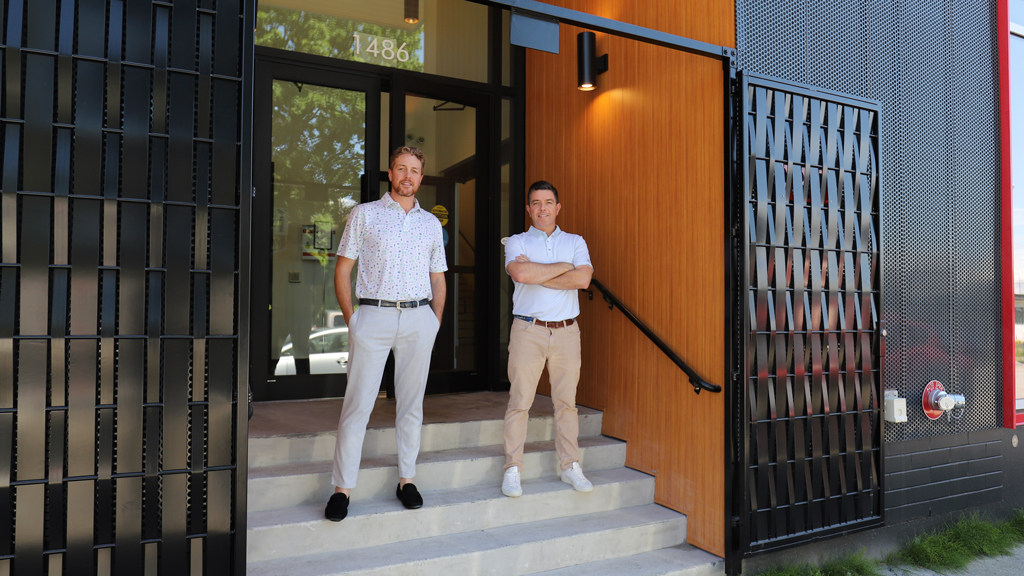At the end of May, Kindred Construction Ltd. moved from its former headquarters in Kitsilano to new, larger offices on Vancouver’s east side.
The move was the last part of a refreshing of the company’s brand, a process that had started a year before.
Founded in 1980 by Dick and Briony Reid, Kindred is now run by their sons Bryan Reid, president, and Matthew Reid, chief operating officer.
“The company started out building custom luxury homes,” said Bryan. “Over time it got into ICI construction and grew into a much larger company. Kindred now had two areas of business with different markets that needed their own brands, to avoid confusing people.”
Bryan says a brand is a necessity for a business, not a luxury.
“A strong brand precedes a personal introduction to a potential customer,” he said. “It establishes a presence in the market and creates trust.”
Matthew joined Kindred in 2016 after a career in finance.
“I knew Kindred’s brand needed refreshing and that the process could be challenging, because I had gone through it with my employer in finance,” he said.
The brothers brought in independent brand strategy consultant Sossina Shenkute to develop a corporate identity that was recognizable in the market and that aligned with Kindred’s business strategy.
“Looking ahead, we hope the brand refresh enables Kindred to have productive conversations with potential customers,” said Shenkute. “We want the refresh to help us grow.”
The market is looking for you to tell them who you are, what you do and what you stand for,
— Laura Potter
hmca
Vancouver design firm hcma went through a similar exercise as Kindred.
Formerly hcma Architecture + Design, hcma’s core discipline is architectural design for (mostly) institutional clients, plus some residential and commercial customers.
“The company has expanded from architecture into communications design and includes brand strategy and graphic design,” said principal Paul Fast.
“We decided to rebrand because our focus had evolved over five years and our brand and business strategies needed to align.
“We wanted a neutral name, to show that the company had become cross-disciplinary, with new perspectives.”
hcma published a large-format, eight-page newsprint broadsheet with the headline, “Allow us to reintroduce ourselves,” and the tagline “Curiosity Applied,” and mailed it out to about 200 of its clients.
“People were tired of Zoom and wanted to have something concrete they could put in their hands,” said Fast.
Laura Potter, client services director for the communication design team, said, “Every company has a brand, whether it knows it or not. It’s your company’s reputation and the face it presents to the world.”
Potter says the absence of a strong brand for your company presents risks.
“It can create a disconnect between what your company really is and how the market sees it,” she said. “The market is looking for you to tell them who you are, what you do and what you stand for.”
Victoria brand strategy consultant Marc Stoiber says the biggest challenge people in construction face comes from selling features and benefits, instead of a vision of the future that the buyer wants.
“It’s a process many companies forget,” said Stoiber. “They figure they can just come up with a logo and tagline and the cash register will ring. It doesn’t happen that way.”
If you want to sell something, you need to position it first, he says.
“You position a product vis a vis the competition. What are your strengths are compared to theirs, what problems you solve better than they do and what sort of customer will find you a better solution than the competition.”
The next step is to start building the brand.
“You brand a product to make it immediately recognizable as the solution you’ve positioned it as,” said Stoiber. “If it’s the simple computer, your brand needs to telegraph simplicity. The reliable bank needs to look and feel reliable.”
Lisa Stevens, BC Construction Association’s chief strategy officer, says a brand is built from a reputation – positive or negative.
“For example, people can get really worked up about a particular airline,” Stevens said. “They’ll do anything to avoid flying with it, maybe because of their own experiences, or their friends’ terrible stories about their last flight with that airline or social media horror stories.”
Stevens says a good way to measure a company’s brand value is by how much word-of-mouth business it gets.
“Are you searching for your project opportunities all the time or are they coming to you?” she said. “If your opportunities are walking through the door, you’re doing something right. You have the makings of a strong brand.”











Recent Comments
comments for this post are closed